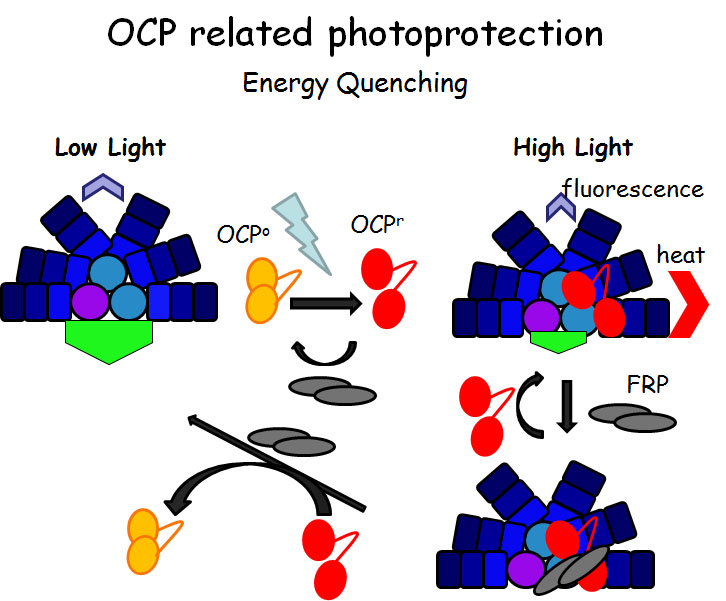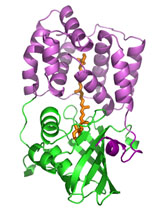Manager
Diana Kirilovsky
More precisely, the main objective of this group is to elucidate and to understand the mechanisms that allow the cyanobacteria to survive and to adapt themselves to conditions in which the quality and quantity of light permanently change.

Light is essential for photosynthetic organisms but it can also be deleterious. Under high irradiance, the excess energy arriving at the photosynthetic reaction centers induces the accumulation of very reactive dangerous species of oxygen which by damaging first the photosynthetic apparatus and then the transcriptional and translational systems lead the cells to death. We have discovered that cyanobacteria, like algae and plants, protect themselves from photo-oxidative damage decreases the excess absorbed energy arriving at the photosynthetic reaction centers by increasing thermal dissipation at the level of the phycobilisomes, the cyanobacterial antenna.
In the last years, large progresses were done in the elucidation of the photoprotection mechanisms by our group. We have demonstrated that the photoactivation of a soluble protein attaching a ketocarotenoid molecule, the Orange Carotenoid Protein (OCP), is essential for the triggering of this photoprotective mechanism. The OCP is formed by an a helix N-terminal domain and a a helix/b sheet C-terminal domain.
The OCP is part of the family of photoreceptors, which are essentials elements to detect environmental changes and it has a particular interest because is the only photosensory protein described to date having a carotenoid as the active chromophore.
 Absorption of strong blue light by the carotenoid induces conformational changes in the carotenoid and in the protein that are essential for its function in a photoprotective mechanism. The dark orange OCP is inactive and has a closed conformation. Upon illumination, the interactions between the two domains are broken and the protein becomes red and adopts an open conformation. The photoactivated red OCP, by interacting with the core of the phycobilisome (PB), increases thermal dissipation of the excess energy absorbed. The C-terminal domain is the sensor of light intensity and the regulator of the activity and the N-terminal domain is the active site where energy is quenched.
Absorption of strong blue light by the carotenoid induces conformational changes in the carotenoid and in the protein that are essential for its function in a photoprotective mechanism. The dark orange OCP is inactive and has a closed conformation. Upon illumination, the interactions between the two domains are broken and the protein becomes red and adopts an open conformation. The photoactivated red OCP, by interacting with the core of the phycobilisome (PB), increases thermal dissipation of the excess energy absorbed. The C-terminal domain is the sensor of light intensity and the regulator of the activity and the N-terminal domain is the active site where energy is quenched.
The Fluorescence Recovery Protein (FRP) is another essential element of  photoprotection. This protein is necessary to recover the full antenna capacity when cells are again under low light conditions. By interacting with the C-terminal domain of the red active OCP, the FRP accelerate the deactivation of the OCP and its detachment from the phycobilisome.
photoprotection. This protein is necessary to recover the full antenna capacity when cells are again under low light conditions. By interacting with the C-terminal domain of the red active OCP, the FRP accelerate the deactivation of the OCP and its detachment from the phycobilisome.
Our work, which increases the knowledge about energy transfer and photoprotection, is also important to develop new cyanobacteria strains more adapted and resistant for biomass and biofuel production. It can be also useful for the development of artificial systems using the sun and water to produce energy. Our expertise on cyanobacterial photosynthesis and regulatory mechanisms has already allows us to begin a collaboration with the industrial Phycosource specialist in the development and selling of natural products isolated from algae and cyanobacteria.